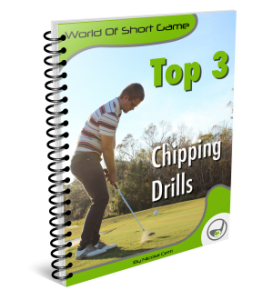- +4527976587
- mail@worldofshortgame.com

Improve Backspin on Chip Shots

Improve Backspin on Chip Shots
Improve Backspin on Chip Shots: Mastering Short Game Control
Welcome to this section where we’re diving into the mechanics of Improve Backspin on Chip Shots—what it is, how it’s created, and what you can do to generate more of it in your chip shots. Mastering backspin isn’t just about creating the dramatic “ball spinning back” on the green that you see in pro tournaments. It’s about understanding the core mechanics that lead to better control, especially when it comes to spin rates (measured in RPMs). In this guide, we’ll also touch on how you can influence the ball’s behavior after it lands, making it check up or spin backward.
What Is Backspin?
In golf, backspin refers to the number of revolutions per minute (RPM) that the ball makes while in flight. More backspin helps control the ball’s flight, affecting both trajectory and the way it behaves upon landing. If you want the ball to check up or spin backward after hitting the green, mastering backspin is essential.
While you may associate backspin with the dramatic backward movement of the ball upon landing, it’s more often about controlling how much the ball will roll after touching down. For most amateur players, understanding how backspin is created will lead to more consistent, controlled chips that get closer to the pin.
Looking to improve your short game? I'm currently offering online lessons through the Skillest app with a 50% discount on your first lesson for all readers of the World of Short Game blog. Simply use the promo code "WOSG50percent" when booking your first session to get started at a discounted rate. Let’s work on your game together! ⛳️
Three Key Factors That Affect Backspin
There are three primary factors that determine how much backspin you can generate on your chip shots:
1-Club Head Speed
The clubhead speed at impact plays a significant role in how much backspin is generated. The faster the club moves through impact, the more potential there is for the ball to spin. However, it’s not just about swinging harder—technique is equally important. Achieving the right combination of speed and control is key to getting the ball to spin effectively.
2-Spin Loft
Spin loft refers to the angle difference between your attack angle and dynamic loft at impact. Let’s break down these terms:
- Attack angle: The path the clubhead takes into the ball—whether it’s moving upward or downward at impact. For chipping, you typically want a downward (negative) attack angle to make clean contact before the ground.
- Dynamic loft: The actual loft on the clubface at the moment of impact. It’s influenced by your setup, particularly shaft lean and clubface position.
The spin loft is essentially the angle between these two elements. A higher spin loft (within limits) leads to more backspin, but if the spin loft becomes too extreme (such as by opening the face too much), you may lose friction, and the ball will slide off the face with less spin.
3-Friction
Friction is critical for generating backspin. For backspin to occur, the club’s grooves need to grip the ball effectively, creating friction at the moment of contact. Clean, sharp grooves on the wedge are essential, and the ball’s surface should be free from debris. Any moisture, dirt, or grass between the club and the ball reduces friction, leading to less spin.
This is similar to how a rubber ping pong paddle creates more spin than a hard, smooth paddle. In the same way, clean grooves and a dry ball allow you to maximize the friction necessary for backspin.
Understanding Spin Loft and Friction Balance
Now that we understand the key factors, let’s dive deeper into the relationship between spin loft and friction. The goal is to maximize spin loft without losing friction, which is tricky and requires a balance.
For example, if you open the clubface too much, it increases the spin loft, but it reduces the amount of friction, making it difficult for the grooves to “grip” the ball. This results in a shot where the ball doesn’t spin as much, and the control diminishes.
The key is to find the right amount of loft and clubface angle that allows you to maintain friction while still generating a high spin loft. This balance varies depending on the shot you are trying to execute, the lie, and environmental conditions.
Practical Tips to Improve Backspin on Chip Shots
Here are some actionable tips to help you improve your backspin on chip shots:
1-Use Lofted Wedges
Using a higher-lofted wedge (such as a 60-degree or 56-degree) makes it easier to generate spin due to the added loft and sharper grooves. Lower-lofted clubs like 9-irons are less effective for producing spin, as the dynamic loft is significantly reduced.
2-Keep Your Grooves Clean
Clean your clubface and grooves regularly. Any dirt, grass, or moisture on the clubface will reduce friction, making it harder to generate backspin. Carry a towel and a groove cleaner during your round to keep your equipment in optimal condition.
3-Ball Position and Shaft Lean
When setting up, avoid placing the ball too far back in your stance, as this can decrease the loft at impact and reduce the spin potential. Instead, play the ball closer to the middle of your stance with a slight forward shaft lean. This setup allows you to maintain loft while ensuring a descending blow to the ball, promoting spin.
4-Ensure Solid Contact
To create maximum friction, ensure clean and solid contact with the ball. The clubface needs to strike the ball first, followed by the turf. This downward strike is key to getting the grooves to grab the ball, increasing spin. If you struggle with solid contact in your chipping checkout our readers favorit article called: 9 Best Chipping Tips
5-Increase Clubhead Speed (Without Sacrificing Control)
While more clubhead speed equals more spin potential, you need to ensure that the added speed doesn’t sacrifice control. Work on accelerating through the ball in a smooth, controlled manner.
How to Practice Backspin
1. Landing Spot Focus Drill
Pick a landing spot on the green and practice hitting chip shots that land in the same area but stop at different distances. This drill helps you understand how backspin affects roll-out after landing, giving you better control over your shots.
2. Spinny Chips Drill
Practice hitting chip shots with a soft golf ball (ideally one with a urethane cover for maximum spin). Focus on creating a downward strike while maintaining clubhead speed. Monitor how much spin you generate and adjust accordingly.
3. Towel Drill
Place a towel a few inches behind the ball and practice making clean contact without hitting the towel. This drill encourages a steeper angle of attack, promoting better contact and spin.
Conclusion: How to Improve Backspin on Chip Shots
Improving backspin on chip shots requires a combination of technique, equipment, and practice. By understanding the balance between spin loft and friction, and making the necessary adjustments in your setup and swing, you can achieve more spin, better control, and greater accuracy.
Remember, maximizing backspin isn’t about swinging harder—it’s about making solid contact with clean grooves, maintaining the right amount of dynamic loft, and hitting the ball with a controlled but aggressive swing. Practice consistently, and you’ll see improvements in how your chip shots check up and spin on the green.
Remember, If you are new to the game of golf, you should checkout the beginners-universe called Golf For Beginners Academy. They provide the best content for beginner golfers!
Looking to improve your short game? I'm currently offering online lessons through the Skillest app with a 50% discount on your first lesson for all readers of the World of Short Game blog. Simply use the promo code "WOSG50percent" when booking your first session to get started at a discounted rate. Let’s work on your game together! ⛳️
You must be logged in to post a comment.



